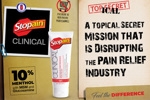
Ready, Set,..Ouch!!! Help Y...
VIEW >

A Topical Secret Mission th...
VIEW >

Not yet a Pro Portal member? Sign up here.
Chiropractors, Physical Therapists, Massage Therapists and other Hands-On Healthcare Professionals are an essential health and wellness resource for individuals of all ages. We partner closely with these professionals on helping people perform better and move ‘pain-free’.
Our topical pain relief products were specifically formulated with these hands-on healthcare professionals (and their patients) in mind. Our fast-acting formulation with penetration enhancers plus 10% menthol, MSM, Glucosamine is like no other. Embracing hands-on healthcare professionals and topical pain relief solutions like Stopain® Clinical provides patients and their families with the ultimate wellness solution.
Visit our clinic locator to find a healthcare professional in your community.

The theory of topicals for muscle aches and pains is sound. I have the office experience to say that Stopain® Clinical and Stopain® Clinical Migraine & Headache with the beneficial added ingredients is effective for headaches and migraines. In a recent Migraine & Headache Summit, I demonstrated the specific way I apply topicals along with fascial therapy to patients in my office. I also teach patients how to self-apply the topicals for headaches and other disorders at home.
During the Migraine & Headache Summit I discussed and demonstrated my hands on step-by-step approach to deep cervical fascial release. The fascia is located just beneath the skin and completely encircles the neck. The procedure assesses the attachments of the investing layer of deep cervical fascia. These include palpation for density, tender points and trigger points in the following areas:
Posteriorly – the spinous processes and attachments of the cervical vertebrae, and the ligamentum nuchae.
Superiorly – the external occipital protuberance and the superior nuchal lines at the base of the skull, the tip of the mastoid process, the lower border of the zygomatic arch, and the lower border of the mandible from the angle to the chin.
Anteriorly – the mandible, the body of the hyoid bone, and the manubrium sterni.
Inferiorly – the sternum and suprasternal attachments, the clavicle with the attachments of the trapezius and sternocleidomastoid muscles, and the acromion of the scapula.
I find the combination of a good topical analgesic combined with fascial therapy, mobilization and manipulation is extremely helpful for headaches. Most headaches are caused by blood vessels in the brain running amok and have some associated inflammatory component. I have a specific pattern of applying topicals for headaches and neck pain. One treatment option is to release ‘sticky’, tight, or dense fascia. I also want the topical to be absorbed into the bloodstream through skin.
Fascial disorders can create pain mechanisms that are remote from the area of pain and discomfort, whereas conditions like knee or cervical osteoarthritis cause pain in the area of degeneration. A local osteoarthritic condition will benefit from a topical right in the area where it hurts. Headaches are a little bit more complicated, so just putting it on where it hurts doesn’t necessarily get at the underlying problem.
Tension headaches often start at the base of the skull where neck muscles tighten, sending up an inflammatory response. Topicals are helpful for the muscle tissue, which could in turn reduce headache pain.
There are such a large range of head and migraine symptoms—including pain, nausea, and sensitivity to light and sound. I am a big user of the ‘entourage’ or multi-modal effect, meaning I combine many modalities that work synergistically with each other. My list of modalities and approaches includes TECAR, laser, radial and Piezowave focused shockwave, vibration/percussion devices (Hyperice), whole body vibration, frequency therapy, Zimmer PEMF, Normatech, SCENAR, and various handheld tools for fascial therapy. Each therapy session is complimented with hands on treatments and some botanical component. These combinations boost active care and recovery.
My hands-on fascial approach can be a stand-alone therapy or used to enhance other modalities such as TECAR heat therapy, laser, and shockwave. All of my headache patients learn how to improve their posture, how to provide auto-traction to the neck, and strengthen the neck-shoulder muscles with exercises. I keep trying different combination approaches that may have a synergistic effect to help these difficult headache patients. The fascial therapy along with a topical complement all other treatments to mitigate pain.
---
JEFFREY TUCKER, DC, is the current president of the American Chiropractic Association (ACA) Rehabilitation Council and practices in West Los Angeles, Calif. He writes for Stopain® Clinical and can be contacted at DrJeffreyTucker.com.